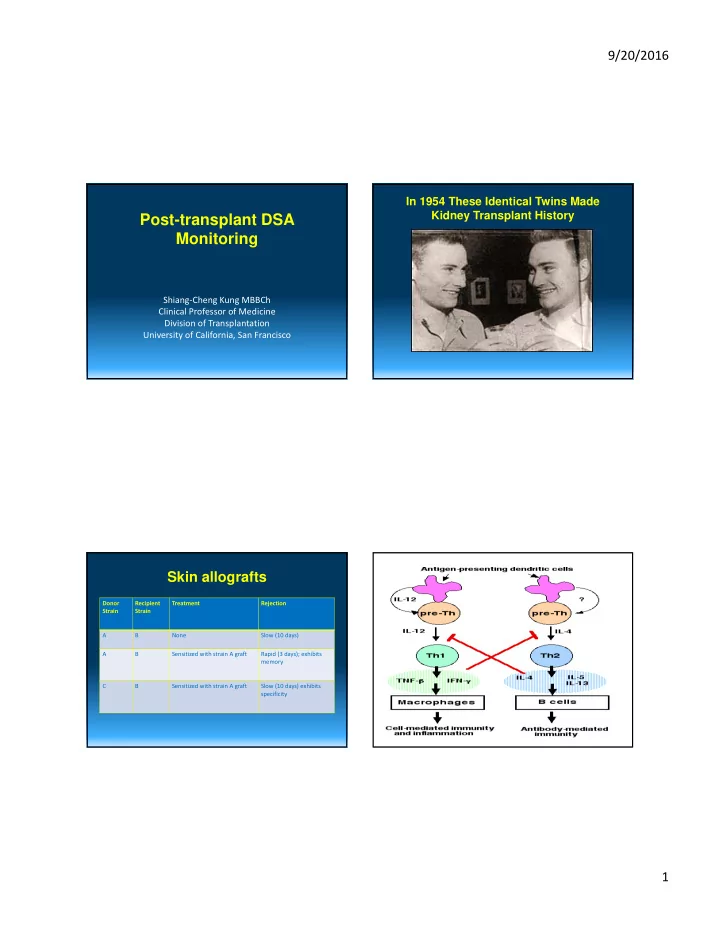

9/20/2016 In 1954 These Identical Twins Made Kidney Transplant History Post-transplant DSA Monitoring Shiang ‐ Cheng Kung MBBCh Clinical Professor of Medicine Division of Transplantation University of California, San Francisco Skin allografts Donor Recipient Treatment Rejection Strain Strain A B None Slow (10 days) A B Sensitized with strain A graft Rapid (3 days); exhibits memory C B Sensitized with strain A graft Slow (10 days) exhibits specificity 1
9/20/2016 The Complement Cascade Li XC, Jenvikar AM: Transplant Immunology; Fig 8.2. Wiley Blackwell. Li XC, Jenvikar AM: Transplant Immunology; Fig 10.2. Wiley Blackwell. 2
9/20/2016 Anti-HLA antibody Detection method – Cell based – Solid phase Preformed De novo Li XC, Jenvikar AM: Transplant Immunology; Fig 5.7. Wiley Blackwell. 11 3
9/20/2016 Clinical and Translational Research Evidence for Antibody-Mediated Injury as a Major Determinant of Late Kidney Allograft Failure Robert S. Gaston, J. Michael Cecka, Bert L. Kasiske, Ann M. Fieberg, Robert Leduc, Fernando C. Cosio, Sita Gourishankar, Joseph Grande, Philip Halloran, Lawrence Hunsicker, Roslyn Mannon, David Rush, and Arthur J Matas Transplantation Volume 90: 68-74 Li XC, Jenvikar AM: Transplant Immunology; Fig 5.8. Wiley Blackwell. 14 Methods One hundred seventy-three subjects transplanted before October 1, 2005 (mean time after transplant) 7.3 ± 6.0 years) had a baseline serum creatinine level of 1.4 ± 0.3 mg/dL before January 1, 2006 and underwent biopsy for new onset graft dysfunction after that date (mean creatinine at biopsy 2.7 ± 16 mg/dL). Kaplan-Meier analysis of the impact of primary or secondary local diagnosis of calcineurin inhibitor (CNI) nephrotoxicity on kidney allograft survival after for-cause biopsy 15 16 4
9/20/2016 Prevalence of anti-HLA Ab Kidney Tx Recipients N=3858 100% 80% 60% 40% 20% 0% 22 117 153 63 25 159 47 161 73 162 458 160 88 204 153 27 109 92 77 54 159 136 259 108 78 79 65 30 N= Centers Kaplan-Meier analysis of the impact of presence or absence of C4d and donor-specific antibody (DSA) on allograft survival after for cause biopsy, by group Terasaki, Ozawa, Am J Transpl 4:438,2004 17 18 The Role of Antibody-Mediated At Year 2 Rejection and Nonadherence in Kidney 193 Graft Failures in Ab + ve Transplant (N = 315) Distribution of attributed causes of failure Graft Almost half of Antibody-Mediated Rejection (ABMR) is due to nonadherence failure Ab +ve 478 15.1% Ab -ve 1743 6.8% Sellarés J, et al . Am J Transplant . 2012;12(2):388-399. PMID: 22081892 19 20 Terasaki,Ozawa, Transplantation, 2005 5
9/20/2016 Summary • Acute antibody mediated rejection accounts for approximately only 20% of the early acute rejection (in first 6 months) • Chronic antibody mediated rejection is a major factor accounting for the allograft loss • Multiple factors may lead to emergency of DSA after the transplant including immunosuppression minimization and poor medication adherence. 6
Recommend
More recommend